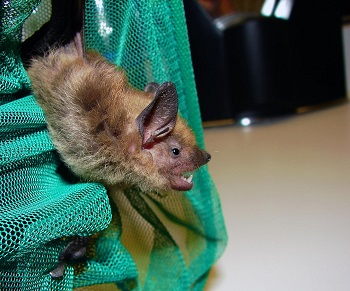Brown University - At some time or another - perhaps at a loud concert or a construction site, for instance - many people have experienced the loss of hearing sensitivity that becomes strikingly evident after the noise subsides. That phenomenon is called a "temporary threshold shift" (TTS) and its occurrence is the norm among a wide variety of animals. But not so for bats. The company of other bats surrounds them with a cloud of incredibly intense sound, yet the results of experiments at Brown University show that their hearing doesn't suffer any significant sensitivity loss from their experience.

In lab experiments big brown bats showed no temporary loss in hearing sensitivity even amid simulations of the the intense noise in which they live. Credit: Matt Reinbold via Flickr https://www.flickr.com/photos/furryscalyman/569023964
"They are naturally exposed to continuous intense sound levels from their own and neighboring sonar emissions while foraging, orienting, and emerging from their roosts," wrote the authors of the article in the Journal of Experimental Biology. "For bats, exposure to prolonged intense wideband sound is an occupational hazard."
Individual bats emit up to 100 to 110 decibels in sound pressure. The combined level of sound pressure among bats flying in groups can increase to 140 decibels, and it can last for several hours, which is comparable to the ambient sound on the deck of an active aircraft carrier.
"This would be like a pounding to a human," said study co-author Kelsey Hom, who graduated from Brown in 2015 and has stayed on as lab manager. One day in a class, Hom asked senior author Andrea Simmons, professor of cognitive, linguistic and psychological sciences and of neuroscience, whether bats experience the same TTS that other animals do. The answer was not known, so a study (and a senior thesis) was born.
High-volume research
They took to the lab to test the hypothesis that bats - in this case big brown bats from Rhode Island - have evolved some way of remaining resilient to their noisy circumstances.
The team, which also included then-lab manager Michaela Warnecke and Professor James Simmons of the neuroscience department, caught wild bats from around Rhode Island and brought them to the lab for a set of experiments. First they trained the bats with extra food rewards to move toward a natural spectrum of bat sound played from a lab speaker if they heard it. Then, they used the bats' newfound skill to test their baseline hearing sensitivity - how quiet a sound could still reliably induce the bat to move toward it. Next, they exposed some bats to the prolonged loudness and range of frequencies they would hear in normal bat life. Other bats were left unexposed to the cacophony as experimental controls. Finally they re-measured the bats' hearing sensitivity again 20 minutes, 2 hours and 24 hours later.
The results showed that unlike in people, fish, birds, rodents and other animals, the bats' hearing sensitivity barely changed. One bat for one timeframe lost about 5 decibels of sensitivity, but on average across seven bats, the total loss was only about 0.6 decibels 20 minutes after exposure. After 24 hours their sensitivity actually improved a similarly insignificant 1.7 decibels. Bats in the control group, who weren't exposed to prolonged loud noise, showed just about as much variation.
"In the literature, the definition of TTS is 6 decibels and above," Andrea Simmons said.
Could this help people?
The study documents the natural resiliency of bats' hearing, but it doesn't explain it.
"We hypothesize that the bat's inner ear may have some special adaptations that allow it to protect itself from loud noises," Simmons said.
The team is eager to learn how bats resist being deafened temporarily, not only for the sake of better understanding bat biology and behavior, but also because it may provide the inspiration to design devices or implants that can help people better weather exposure to loud noises.
"Bats have always been looked at as a model for sonar, with the goal of technological development, but these data suggest that they could be looked at as a biomedically related model as well," Simmons said.
The Office of Naval Research (grant: N000141410588), the Capita Foundation and Brown University funded the research.
Source: https://www.eurekalert.org/pub_releases/2016-03/bu-lia032416.php

